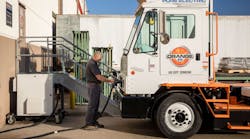I cannot state this anymore emphatically: terminal tractors are a perfect "use case" for battery-electric vehicles. And they are a great way for fleets to dip their toes into the commercial battery-electric vehicle pool.
Terminal tractors rarely operate outside of the fleet’s own terminal. Their sole function is to move trailers around the yard. Mileage per day on terminal tractors is low—extremely low. In Run on Less—Electric (RoL-E), three terminal tractors varied from a high mileage of 29 miles a day to a low of 14. Range is not an issue with this market segment. One concern addressed.
See also: It’s 'go time' for electrification
The nature of the operation of terminal tractors means charging takes place on-site and makes them prime candidates for what is known as opportunity charging. The three fleets in RoL-E operating terminal tractors talked about how drivers plug the vehicles in when they are on breaks, at lunch, or doing paperwork. Placing a charging station near the drivers’ breakroom allows that opportunity charging to happen seamlessly. Another concern addressed.
While electric terminal tractors cost more than their diesel counterparts, because of their low mileage and their ability to opportunity charge, fleets may be able to reduce the size of the battery pack they spec, which will lower the cost without sacrificing performance. Another concern partially addressed.
Today, electric terminal tractors from both existing OEMs and some new manufacturers are available and are direct replacements for virtually all diesel-powered terminal tractor use cases with very few operational adjustments.
See also: Learn from those who are doing
One issue with determining whether electric terminal tractors make sense is the fact that few fleets actually have good data on what their terminal tractors are costing them. So, I suggest before adding an electric terminal tractor spend some time tracking the expenses associated with your current fleet of diesel-powered terminal tractors to see what they are costing you to operate.
Then go ahead and bring in one or more electric terminal tractors. Track those costs; I am sure you will want to do that since the electric versions of terminal tractors cost significantly more than their diesel counterparts. [Note: Available incentives can help reduce initial purchase price.] Make sure to include data from the charging equipment and the electric meter. In some cases, your local utility will recommend that you have a separate meter for vehicle charging.
Regardless of the number of terminal tractors you have, it really makes a great deal of sense to switch over to electric-powered units. Not only are they better for the environment, but they also will allow you to learn a great deal about how EVs in commercial applications perform which is information you can leverage as you move other parts of your operation to electric vehicles. Think about it, the terminal tractor segment of trucking really is 100% electrifiable. What are you waiting for?
Michael Roeth has worked in the commercial vehicle industry for nearly 30 years, most recently as executive director of the North American Council for Freight Efficiency. He serves on the second National Academy of Sciences Committee on Technologies and Approaches for Reducing the Fuel Consumption of Medium and Heavy-Duty Vehicles and has held various positions in engineering, quality, sales, and plant management with Navistar and Behr/Cummins.




